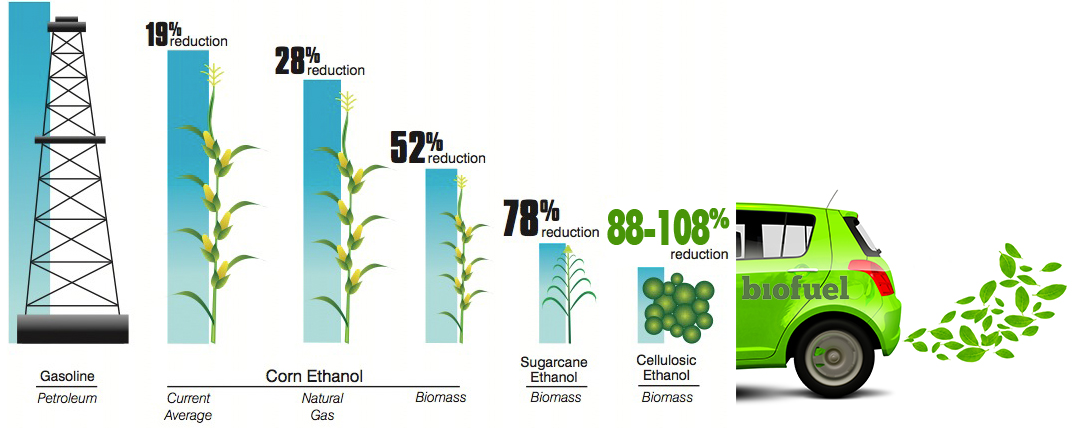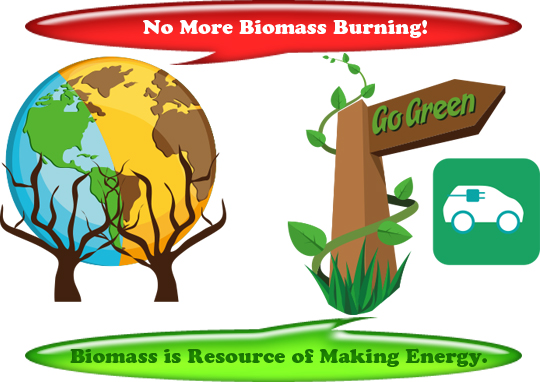![]()
Biomass is an Ideal Feedstock.
Biomass is inexpensive and reliable raw materials for highly valuable green fuels and chemicals.

Exceptional CO₂ Reduction
Biofuels play a central role in Climate Action Plans.
Biomass-based Cellulosic Biofuels can reduce GHG more than any other fuel.
Emergent cellulosic biofuels, derived from the fibrous – or cellulosic – material in plants, provide GHG savings in the range of 88-108% (Argonne). Because biomass (i.e. plants, agricultural crops or residues, municipal wastes) has the potential to substantially curb greenhouse gas (GHG) emissions by having a very small net CO₂ impact compared to fossil fuels.
One of the biggest consumers of crude oil is the transport sector – it uses up to 70% of global oil production every year and significantly contributes to climate change, accounting for around 25%~30% of man-made greenhouse gas emissions globally. Thus, biofuels are the primary route to more sustainable mobility and to more independence from fossil resources.

Infinitely Renewable
Fossil fuels take millions of years to form within the Earth. Once we use up our reserves of fossil fuels, there is nothing more left. On the contrary, bioenergy, or energy derived from biomass, is a sustainable alternative to fossil fuels because it can be produced from renewable sources such as plants and waste that can be continuously replenished.

The Lowest-cost Feedstock
Lignocellulosic biomass is the most promising feedstock considering its great availability and low cost. Utilizing cellulosics is to tap the earth’s most abundant and readily renewable resource, and can provide our industry with fairly inexpensive and reliable raw materials.

No Competition with Food
Biofuels and biochemicals are an irresistible paradigm.
But those based on edible crop have no viable future.
Many of the problems associated with first-generation biofuels which are produced directly from food crops (i.e. starch, sugar, animal fats, and vegetable oil) can be solved by the production of second generation biofuels manufactured from abundant ligno-cellulosic materials such as cereal straw, sugar cane bagasse, forest residues, and wastes. As the debate on food versus fuel intensifies, biomass can provide added income to farmers without compromising the production of main food and even non-food crops.

Attractive Alternative to Waste Treatment
Cellulosic biomass residues are abundant and conversion into green fuels and chemicals can represent an alternative to waste handling/treatment.
Globally, 140 billion metric tons of biomass is generated every year from agriculture. However, biomass is still largely under utilized and left to rot or openly burned in the fields, especially in developing countries that do not have strong regulatory instruments to control such pollutive practices. As a common practice, direct combustion of agricultural residue results in air pollution thereby posing risk to human and ecological health. Biomass is a renewable resource that causes problems when not used.
This volume of biomass can be converted to an enormous amount of energy and raw materials. Equivalent to approximately 50 billion tons of oil, agricultural biomass waste converted to energy can substantially displace fossil fuel, reduce emissions of greenhouse gases and provide renewable energy to some 1.6 billion people in developing countries, which still lack access to electricity.
So to speak, widely available, renewable, and virtually free, waste biomass is an important resource. To divert this waste for material and energy recovery would reduce the costs for waste disposal and would generate the revenue from the sale of the recovered materials and energy.




 COPYRIGHT © 2016 ARKENOL & AKR. ALL RIGHTS RESERVED.
COPYRIGHT © 2016 ARKENOL & AKR. ALL RIGHTS RESERVED.